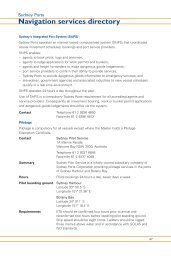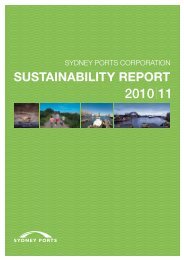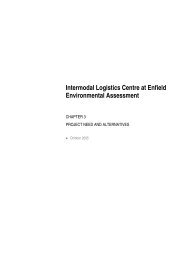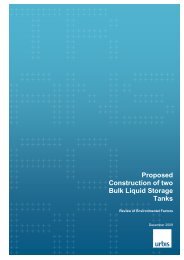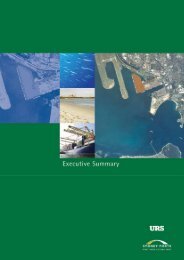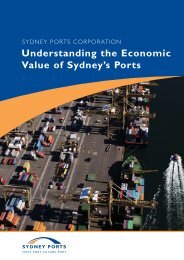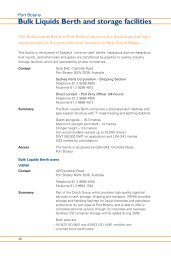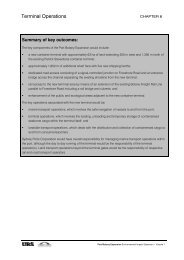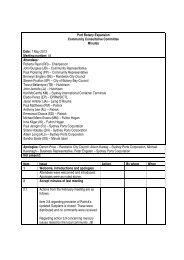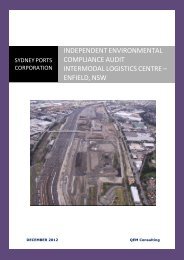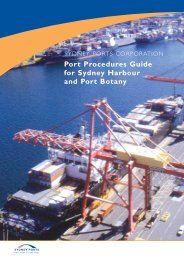SYDNEY PORTS CORPORATION ANNUAL REPORT 12
SYDNEY PORTS CORPORATION ANNUAL REPORT 12
SYDNEY PORTS CORPORATION ANNUAL REPORT 12
Create successful ePaper yourself
Turn your PDF publications into a flip-book with our unique Google optimized e-Paper software.
76<br />
Sydney PortS CorPoration<br />
noteS to the FinanCiaL StateMentS<br />
note 16. finanCial riSk management oBJeCtiveS and PoliCieS (ContinUed)<br />
i) Interest rate risk<br />
Exposure to interest rate risk arises primarily through the Corporation’s interest-bearing loans. The Corporation’s debt<br />
portfolio is comprised of fixed rate borrowings with a range of maturities over a number of years. The balance and<br />
composition of the portfolio is governed by a Corporation policy document which establishes prudential limits on the<br />
amount of debt that can mature in a given financial period. The policy establishes that from 1 July 2014 no more than 20%<br />
of the face value of the core portfolio can mature in any <strong>12</strong> month period. The policy also limits the type of instruments that<br />
can be obtained.<br />
TCorp manages interest rate risk exposures applicable to specific borrowings of the Corporation in accordance with a debt<br />
portfolio mandate agreed between the two parties. TCorp receives a fee for this service, which includes a performance<br />
component where TCorp is able to add value by achieving a reduction in the Corporation’s debt costs against an agreed<br />
benchmark. TCorp uses derivatives, primarily interest rate futures, to establish short term (tactical) and longer term<br />
(strategic) positions within agreed tolerance limits to manage portfolio duration and maturity profiles (refer to note 16(b)(ii)).<br />
The Corporation does not account for any fixed rate loans at fair value through profit or loss or as available-for-sale.<br />
Therefore, for these loans, a change in interest rates would not affect profit or loss or equity.<br />
A reasonably possible change of +/– 1% is used, consistent with current trends in interest rates. The basis is reviewed<br />
annually and amended where there is a structural change in the level of interest rate volatility.<br />
The Corporation’s exposure to interest rate risk (excluding interest rate future contracts) is set out below.<br />
Sydney PortS CorPoration finanCial rePort 2011/<strong>12</strong><br />
Carrying<br />
amoUnt<br />
$000<br />
+1% (100 BaSiS PointS) -1% (100 BaSiS PointS)<br />
PoSt taX<br />
imPaCt on<br />
Profit<br />
$000<br />
eQUity<br />
$000<br />
PoSt taX<br />
imPaCt on<br />
Profit<br />
$000<br />
eQUity<br />
$000<br />
At 30 June 20<strong>12</strong><br />
Financial assets<br />
Cash and cash equivalents 92,828 650 – (650) –<br />
Trade and other receivables 1,459 10 – (10) –<br />
Financial liabilities<br />
94,287 660 – (660) –<br />
Interest-bearing loans and borrowings 604,574 – – – –<br />
Net exposure<br />
At 30 June 2011<br />
Financial assets<br />
(510,287) 660 – (660) –<br />
Cash and cash equivalents 156,858 1,098 – (1,098) –<br />
Trade and other receivables 1,013 7 – (7) –<br />
Financial liabilities<br />
157,871 1,105 – (1,105) –<br />
Interest-bearing loans and borrowings 603,826 – – – –<br />
Net exposure (445,955) 1,105 – (1,105) –<br />
ii) Interest rate futures contracts<br />
Interest rate futures contracts are entered into by TCorp on behalf of the Corporation to establish short term (tactical)<br />
and long term (strategic) positions within agreed tolerance limits to manage debt portfolio duration and reduce<br />
borrowing costs over time. Therefore, the Corporation is exposed to the interest rate risk of these contracts without<br />
being a party to the contracts.<br />
The outstanding futures positions are not on the balance sheet as they represent the nominal value of the underlying<br />
instrument. The change in market value of these positions is recognised in profit or loss in the statement of comprehensive<br />
income in the line item “Finance costs”. The increase in finance costs as a result of these positions in the year ended<br />
30 June 20<strong>12</strong> was $6.984 million (2011: $0.373 million decreased).



